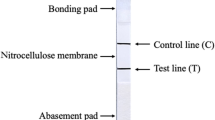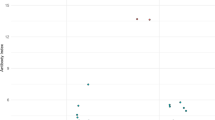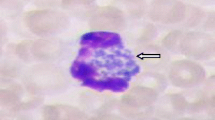Abstract
An ELISA based on a recombinant Theileria annulata surface protein (TaSP) was evaluated for detection of antibodies in sera from cattle exposed to tropical theileriosis in Sudan. The reference positive samples, used in this study, were from Theileria-infected populations and consisted of 80 cattle from an endemic area in Khartoum State, with high antibody titers in the indirect fluorescent antibody test (IFAT). The reference negative samples were taken from non-exposed populations and consisted of 120 cattle maintained under strict tick control at a commercial farm in Sudan. The cut-off value determined by Two-Graph Receiver-Operating Characteristic (TG-ROC) curves was set at 31.6%, based on the positive reference samples. Further diagnostic validation was performed, which consisted of the measurement of the area under the ROC (AUC) and by valid range proportion (VRP), which was 0.97 and 0.98 for the cut-off, respectively. There were no cross-reactions with antibodies raised against Babesia spp. It is concluded that the TaSP ELISA is a useful test for the diagnosis of T. annulata infection in cattle under field conditions.







Similar content being viewed by others

References
Bakheit MA, Schnittger L, Salih DA, Boguslawski K, Beyer D, Fadl M, Ahmed JS (2004) Application of the recombinant Theileria annulata surface protein in an indirect ELISA for the diagnosis of tropical theileriosis. Parasitol Res 92:299–302
Barajas-Rojas JA, Riemann HP, Franti CE (1993) Notes about determining the cut-off value in enzyme linked immunosorbent assay (ELISA). Prev Vet Med 15:231–233
Boulter NR, Brown CGD, Kirvar E, Glass E, Campbell J, Morzaria S, Nene V, Musoke A, d’Oliveira C, Gubbels MJ, Jongejan F, Hall R (1998) Different vaccine strategies used to protect against Theileria annulata. Ann NY Acad Sci 849:234–246
Brown CGD (1990) Control of tropical theileriosis (Theileria annulata infection of cattle). Parasitologia 32:23–31
Dolan TT (1989) Theileriosis: a comprehensive review. Rev Sci Tech Off Int Epiz 8:11–36
d’Oliveira C, van der Weide M, Habela MA, Jacquiet P, Jongejan F (1995) Detection of Theileria annulata in blood samples of carrier cattle by PCR. J Clin Microbiol 13:2665–2669
de Kok JB, d’Oliveria C, Jongejan F (1993) Detection of the protozoan parasite Theileria annulata in Hyalomma ticks by the polymerase chain reaction. Exp Appl Acarol 17:839–846
El Ghali AA, ElHussein AM (1995) Diseases of livestock in EdDamer Province, El Nile State, Sudan: a Two-year retrospective study. Sud J Vet Anim Husb 34:37–45
Elhaj MT, Hamid ME (2003) Haematological and serum chemistry studies on crossbred calves infected with Theileria species. Sud J Vet Sci Anim Husb 42:128–140
FAO (1984) Tick and tick-borne diseases control. A practical field manual, vol II. Food and Agriculture Organization of the United Nations, Rome
Galen RS (1986) Use of predictive value theory in clinical immunology. In: Rose NR, Friedman H, Fahey JL (eds) Manual of clinical laboratory immunology, 3rd edn. American Society for Microbiology, Washington, DC, pp 966–970
Greiner M (1995) Two-graph receiver-operating characteristic (TG-ROC): a Microsoft-EXCEL template for the selection of cut-off values in diagnostic tests. J Immunol Methods 185:145–146
Greiner M, Franke CR, Bohning D, Schlattman P (1994) Construction of an intrinsic cut-off value for the sero-epidemiological study of Trypanosoma evansi infections in a canine population in Brazil: a new approach towards an unbiased estimation of prevalence. Acta Trop 56:97–109
Greiner M, Sohr D, Gobel P (1995) A modified ROC analysis for the selection of cut-off values and the definition of intermediate results of serodiagnostic tests. J Immunol Methods 185:123–132
Greiner M, Pfeiffer D, Smith RD (2000) Principles and practical application of the receiver-operating characteristic analysis for diagnostic tests. Prev Vet Med 45:23–41
Gubbels JM, d’Oliveira C, Jongejan F (2000) Development of an indirect Tams1 enzyme-linked immunosorbent assay for diagnosis of T. annulata infection in cattle. Clin Diag Lab Immunol 3:404–411
Ilhan T, Williamson S, Kirvar E, Shiels B, Brown CGD (1998) Theileria annulata: carrier and immunity. Ann NY Acad Sci 849:109–125
Jacobson R (1996) Principles of validation of diagnostic assays for infectious diseases. In: Office international des epizooties standards commission (ed) Manual of standards for diagnostic tests and vaccines, 3rd edn. Office international des epizooties paris, France, pp 8–15
Kiltz HH, Uilenberg G, Franssen FFJ, Perié NM (1986) Theileria orientalis occurs in Central Africa. Res Vet Sci 40:197–200
Manuja A, Nichani AK, Kumar R, Rakha NK, Kumar B, Sharma KD (2000) Comparison of cellular schizont, soluble schizont and soluble piroplasm antigens in ELISA for detecting antibodies against Theileria annulata. Vet Parasitol 87:93–101
Martin SW (1984) Estimating disease prevalence and the interpretation of screening test results. Prev Vet Med 2:463–472
Mboloi MM, Cornelis PJ, Kruitwagen C, Greiner M, Jongejan F (1999) Validation of the indirect MAP1-B enzyme-linked immunosorbent assay for diagnosis of experimental Cowdria ruminantium infection in small ruminants. Clin Diag Lab Immun 6:66–72
Metz CE (1998) ROCKIT 0.9B. Beta Version. www-radiology.uchicago. edu/krl/toppage11.htm
Norval RA (1992) In: Perry BD, Young AS (eds) The epidemiology of Theileriosis in Africa. Academic Press, NY, 481pp
Pipano E, Cahana M (1969) Fluorescent antibody test for the serodiagnosis of Theileria annulata. J Parasitol 55:765
Schnittger L, Katzer F, Biermann R, Shayan P, Boguslawski K, Mckellar S, Beyer D, Shiels BR, Ahmed JS (2002) Characterization of a polymorphic Theileria annulata surface protein (TaSP) closely related to PIM of Theileria parva: implications for use in diagnostic tests and subunit vaccines. Mol Biochem Parasitol 120:247–256
Simel DL, Feussner JR, DeLong ER, Matchar DB (1987) Intermediate, indeterminate, and uninterpretable diagnostic test results. Med Decis Making 7:107–114
Smith RD (1991) Evaluation of diagnostic test. In: Smith RD (ed) Veterinary clinical epidemiology. Butterworth-Heinemann, Stoneham MA, pp 29–43
Voller A, Bidwell DE, Bartlett A, Edwards R (1977) A comparison of isotopic and enzyme-immunoassays for tropical parasitic disease. Trans R Soc Trop Med Hyg 71:431–437
Williamson S, Tait A, Brown D, Walker A, Beck P, Shiels B, Fletcher J, Hall R (1989) Theileria annulata sporozoite surface antigen expressed in Escherichia coli elicits neutralizing antibody. Proc Natl Acad Sci USA 86:4639–4643
Wright PF, Nilsson E, Van Rooij EMA, Lelenta M, Jeggo MH (1993) Standardization and validation of enzyme-linked immunosorbent assay techniques for the detection of antibody in infectious disease diagnosis. Rev Sci Tech Off Int Epiz 12:435–450
Youden D (1950) Index for rating diagnostic tests. Cancer 3:32–35
Zweig MH, Campbell G (1993) Receiver-operating characteristic (ROC) plots: a fundamental evaluation tool in clinical medicine. Clin Chem 39:561–577
Acknowledgements
This research was partially supported by the International Atomic Energy Agency (IAEA) through the Project No. SUD/05/027 entitled “Control of Ticks and Tick-borne Diseases”. Additional support was provided by the European Union (INCO-Dev programme, contract number ICA4-CT-2000-300028). An additional support was provided by the ICTTD Concerted Action Project on Integrated Control of Ticks and Tick-borne Diseases, supported by the INCO-DC Program of the European Union under contract no. IC18-CT95-0009. We thank Dr. R. Hashemi-Fesharki, Head Department of Protozoology and Protozoa Vaccine, Razzi Institute, Iran for the kind provision of the positive control serum and Dr. E. D. M. ELAmin, CVRL, Sudan for his critical review of the manuscript. Our thanks are also extended to Dr. M. Greiner for his valuable suggestions and comments. This work is published by kind permission of the Director-General Animal Resources Research Corporation.
Author information
Authors and Affiliations
Corresponding author
Additional information
Omer E. Shariff Deceased.
Rights and permissions
About this article
Cite this article
Salih, D.E.A., Ahmed, J.S., Bakheit, M.A. et al. Validation of the indirect TaSP enzyme-linked immunosorbent assay for diagnosis of Theileria annulata infection in cattle. Parasitol Res 97, 302–308 (2005). https://doi.org/10.1007/s00436-005-1431-6
Received:
Accepted:
Published:
Issue Date:
DOI: https://doi.org/10.1007/s00436-005-1431-6



